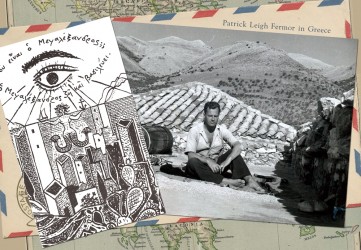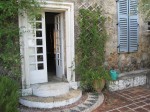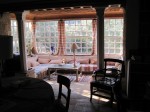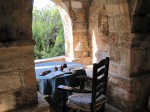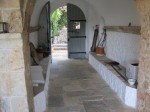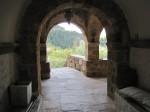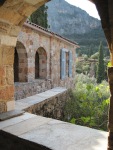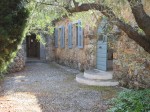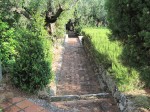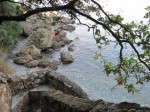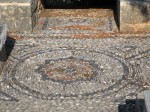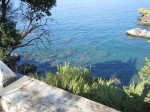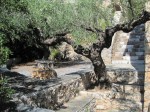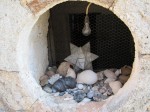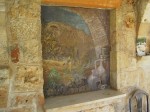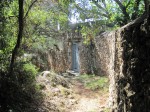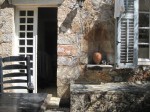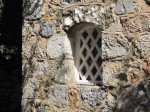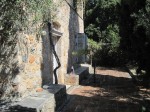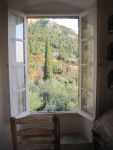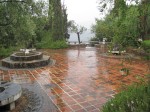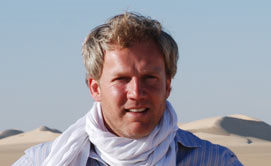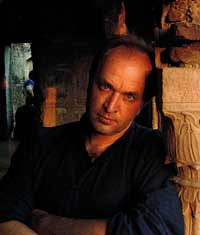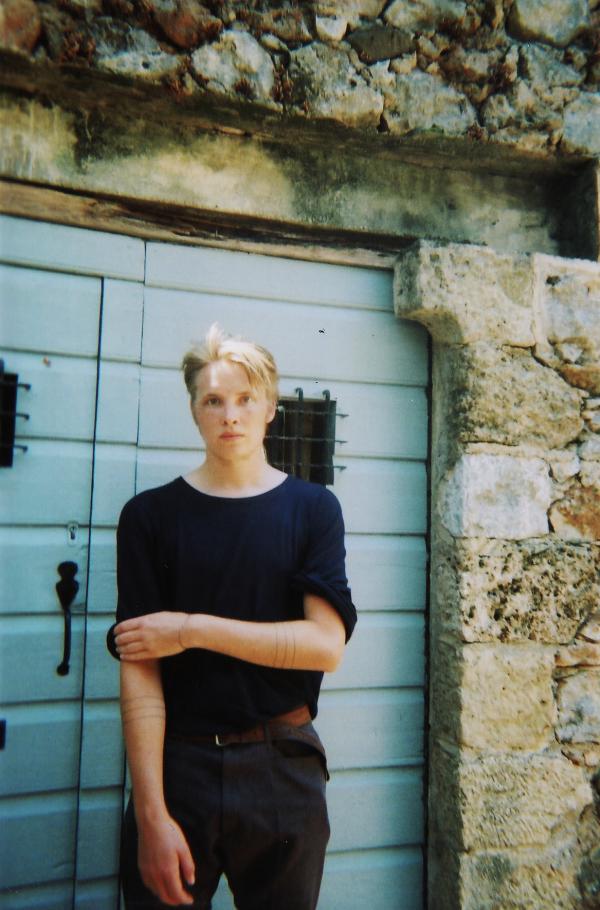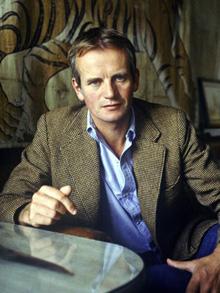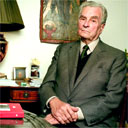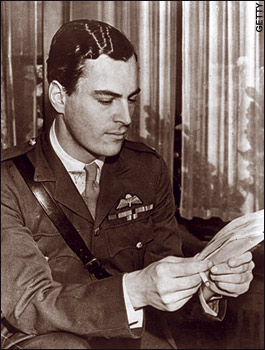
Patrick Leigh Fermor was a major in the Paras during the Second World War
This profile by William Dalrymple is perhaps the most well known of all the on-line pieces about Paddy. I have so far been reluctant to add it to the blog, but as my blog is meant to be a ‘one-stop shop’ for all things Leigh Fermor I have decided its time has come.
By William Dalrymple
First published in the Telegraph 06 Sep 2008
At 18 he left home to walk the length of Europe; at 25, as an SOE agent, he kidnapped the German commander of Crete; now at 93, Patrick Leigh Fermor, arguably the greatest living travel writer, is publishing the nearest he may come to an autobiography – and finally learning to type. William Dalrymple meets him at home in Greece
‘You’ve got to bellow a bit,’ Sir Patrick Leigh Fermor said, inclining his face in my direction, and cupping his ear. ‘He’s become an economist? Well, thank God for that. I thought you said he’d become a Communist.’
He took a swig of retsina and returned to his lemon chicken.
‘I’m deaf,’ he continued. ‘That’s the awful truth. That’s why I’m leaning towards you in this rather eerie fashion. I do have a hearing aid, but when I go swimming I always forget about it until I’m two strokes out, and then it starts singing at me. I get out and suck it, and with luck all is well. But both of them have gone now, and that’s one reason why I am off to London next week. Glasses, too. Running out of those very quickly. Occasionally, the one that is lost is found, but their numbers slowly diminish…’
He trailed off. ‘The amount that can go wrong at this age – you’ve no idea. This year I’ve acquired something called tunnel vision. Very odd, and sometimes quite interesting. When I look at someone I can see four eyes, one of them huge and stuck to the side of the mouth. Everyone starts looking a bit like a Picasso painting.’
He paused and considered for a moment, as if confronted by the condition for the first time. ‘And, to be honest, my memory is not in very good shape either. Anything like a date or a proper name just takes wing, and quite often never comes back. Winston Churchill – couldn’t remember his name last week.
‘Even swimming is a bit of a trial now,’ he continued, ‘thanks to this bloody clock thing they’ve put in me – what d’they call it? A pacemaker. It doesn’t mind the swimming. But it doesn’t like the steps on the way down. Terrific nuisance.’
We were sitting eating supper in the moonlight in the arcaded L-shaped cloister that forms the core of Leigh Fermor’s beautiful house in Mani in southern Greece. Since the death of his beloved wife Joan in 2003, Leigh Fermor, known to everyone as Leigh Fermor, has lived here alone in his own Elysium with only an ever-growing clowder of darting, mewing, paw-licking cats for company. He is cooked for and looked after by his housekeeper, Elpida, the daughter of the inn-keeper who was his original landlord when he came to Mani for the first time in 1962.
It is the most perfect writer’s house imaginable, designed and partially built by Leigh Fermor himself in an old olive grove overlooking a secluded Mediterranean bay. It is easy to see why, despite growing visibly frailer, he would never want to leave. Buttressed by the old retaining walls of the olive terraces, the whitewashed rooms are cool and airy and lined with books; old copies of the Times Literary Supplement and the New York Review of Books lie scattered around on tables between Attic vases, Indian sculptures and bottles of local ouzo.
A study filled with reference books and old photographs lies across a shady courtyard. There are cicadas grinding in the cypresses, and a wonderful view of the peaks of the Taygetus falling down to the blue waters of the Aegean, which are so clear it is said that in some places you can still see the wrecks of Ottoman galleys lying on the seabed far below.
There is a warm smell of wild rosemary and cypress resin in the air; and from below comes the crash of the sea on the pebbles of the foreshore. Yet there is something unmistakably melancholy in the air: a great traveller even partially immobilised is as sad a sight as an artist with failing vision or a composer grown hard of hearing.
I had driven down from Athens that morning, through slopes of olives charred and blackened by last year’s forest fires. I arrived at Kardamyli late in the evening. Although the area is now almost metropolitan in feel compared to what it was when Leigh Fermor moved here in the 1960s (at that time he had to move the honey-coloured Taygetus stone for his house to its site by mule as there was no road) it still feels wonderfully remote and almost untouched by the modern world.
When Leigh Fermor first arrived in Mani in 1962 he was known principally as a dashing commando. At the age of 25, as a young agent of Special Operations Executive (SOE), he had kidnapped the German commander in Crete, General Kreipe, and returned home to a Distinguished Service Order and movie version of his exploits, Ill Met by Moonlight (1957) with Dirk Bogarde playing him as a handsome black-shirted guerrilla.
It was in this house that Leigh Fermor made the startling transformation – unique in his generation – from war hero to literary genius. To meet, Leigh Fermor may still have the speech patterns and formal manners of a British officer of a previous generation; but on the page he is a soaring prose virtuoso with hardly a single living equal.
It was here in the isolation and beauty of Kardamyli that Leigh Fermor developed his sublime prose style, and here that he wrote most of the books that have made him widely regarded as the world’s greatest travel writer, as well as arguably our finest living prose-poet. While his densely literary and cadent prose style is beyond imitation, his books have become sacred texts for several generations of British writers of non-fiction, including Bruce Chatwin, Colin Thubron, Philip Marsden, Nicholas Crane and Rory Stewart, all of whom have been inspired by the persona he created of the bookish wanderer: the footloose scholar in the wilds, scrambling through remote mountains, a knapsack full of books on his shoulder.
As Anthony Lane put it in the New Yorker, Leigh Fermor ‘was, and remains, an Englishman, with so much living to his credit that the lives conducted by the rest of us seem barely sentient – pinched and paltry things, laughably provincial in their scope… We fret about our kids’ Sats, whereas this man, when he was barely more than a kid himself, walked from Rotterdam to Istanbul. In his sixties he swam the Hellespont, in homage to Lord Byron – his hero, and to some extent his template. In between he has joined a cavalry charge, observed a voodoo ceremony in Haiti, and plunged into a love affair with a princess. He has feasted atop a moonlit tower, with wine and roast lamb hauled up by rope. He has dwelt soundlessly among Trappist monks.’
For myself, it was the reading of his travel books while at Cambridge that inspired me to attempt to follow in his footsteps. With a paperback of Leigh Fermor’s in my backpack, I set off to Jerusalem following the route of the Crusaders during my first summer vacation. Meeting my hero for the first time at Bruce Chatwin’s house, just before the publication of my first book in 1989, was the nearest thing I have had to a formal graduation ceremony as a writer, the moment when you suddenly feel that maybe you really have passed out of your novitiate.
Foremost among Leigh Fermor’s books are his two glorious Greek travelogues, Mani and Roumeli; an exquisite short study of monasticism, A Time to Keep Silence; and most celebrated of all, an account of his journey in the early 1930s, travelling on foot, sleeping in hayricks and castles ‘like a tramp, a pilgrim, or a wandering scholar’, from Holland to Constantinople. On and off for nearly 70 years Fermor has been working on a trilogy about this epic walk. The first volume – and many would say his masterpiece – A Time of Gifts was finally published in 1977. The second, Between the Woods and the Water, followed nine years later. Since then, 22 years have passed with no sign of volume three, the book that should take us to the gates of Byzantium.
Leigh Fermor is now 93 and his fans are getting anxious. But travel writers have longer professional life expectancies than most – Norman Lewis, for example, produced four books between his 88th birthday and his death five years later – so we should not give up hope. Indeed, on a low table when Leigh Fermor showed me into his study, lay an 8in-high pile of manuscript, some of it ring-bound, and some in folders, on which was scribbled in red felt-tip: Vol 3.
In the meantime, Fermor fans have a small savoury to keep them going until the final course is served. This week John Murray is bringing out In Tearing Haste, a volume of letters between Leigh Fermor and the last surviving member of the Mitford sisterhood: Debo Devonshire, his close friend for nearly half a century. The letters are the nearest thing Leigh Fermor may ever get to writing an autobiography, faithfully chronicling his movements since the mid-1950s with the same detailed, painterly, highly written style that he uses in his travelogues.
Though inevitably slighter than his more polished work, the book includes wonderful accounts of some of his most celebrated adventures, such as his disastrous visit to Somerset Maugham at Cap Ferrat. Here he describes the elderly Maugham’s face as ‘so discoloured and green that it looks as though he has been rotting in the Bastille, or chained to a bench of a galley, or inside an iron mask for half a century’.
Having committed the faux-pas of appearing to draw attention to Maugham’s stammer at dinner, Leigh Fermor, who had initially been invited to stay for a week, was approached by his host at the end of the evening who offered him ‘a hand as cold as a toad, with the words “W-w-well I’ll s-s-say g-good-b-b-bye now in c-case I’m not up b-by the t-time y-you l-leave.”?’
It emerged that Leigh Fermor’s proof of the book had yet to reach the Peloponnese, so after supper I produced my own copy. He frowned: there had been a disagreement between the authors and their publisher over the cover produced by the artist John Craxton, who has illustrated all Leigh Fermor’s book since the 1950s, and the book was now covered with something more sketchy, and clearly not at all to Leigh Fermor’s liking. ‘Debo and I complained,’ he said, holding the book almost to the end of his nose and peering disapprovingly at the illustration, ‘but they kept on about business trends or some such jargon. What was it now? Market forces, that’s it. Well I never…’
As he flicked through the proof, I asked if the rumours were true: that after a lifetime of writing in longhand, he was now finally learning to type, the quicker to finish the third volume of his masterpiece.
‘Well, not exactly,’ he replied. ‘At the moment I seem to be collecting typewriters. I’ve got four now. People keep giving me their old ones. But it is true, I am planning to take typing lessons in Evesham this September.’ He paused, before adding, ‘In truth, I am absolutely longing to get down to it, before my sight gets any worse.’
 Patrick Leigh Fermor was born in London in 1915 to Sir Lewis Leigh Fermor, the director general of the Geological Survey of India, and the ‘sophisticated and wild’ Eileen Ambler. His mother was a bohemian and highly literate woman, who loved reading to her children and encouraging them to learn poetry by heart. She had been brought up in the wilds of Bihar, as a result of which Leigh Fermor can still sing, It’s a Long Way to Tipperary in Hindi. ‘Although I was brought up in England,’ he remembered, ‘India was a presence in the household, like voices in the next room.’
Patrick Leigh Fermor was born in London in 1915 to Sir Lewis Leigh Fermor, the director general of the Geological Survey of India, and the ‘sophisticated and wild’ Eileen Ambler. His mother was a bohemian and highly literate woman, who loved reading to her children and encouraging them to learn poetry by heart. She had been brought up in the wilds of Bihar, as a result of which Leigh Fermor can still sing, It’s a Long Way to Tipperary in Hindi. ‘Although I was brought up in England,’ he remembered, ‘India was a presence in the household, like voices in the next room.’
Almost immediately Leigh Fermor was deserted by his parents. It was the war, and they had to return to India; given the threat of U-boats, it was decided to leave the young Leigh Fermor in England so that someone would survive if the ship were torpedoed. The boy was sent to a farm in Northamptonshire where he was allowed to run free. ‘I think it formed me, you know,’ he said. ‘Made me restless and curious. I was constantly climbing trees and hayricks.’
When his mother and sister returned to collect him three and half years later, he ran away from these ‘beautiful strangers’. In retrospect, Leigh Fermor thinks the experience of ‘those marvellously lawless years unfitted me for the faintest shadow of constraint’, something that marked the rest of his career, especially at school, where he was expelled from a variety of establishments until finding happiness at ‘a co-educational and very advanced school for difficult children’.
After that school was closed down due to a series of ‘vaguely guessed at improprieties’, Leigh Fermor moved on to the King’s School Canterbury. He liked the fact it was founded during the reign of Justinian ‘when fragments of Thor and Odin had barely stopped smouldering in the Kentish woods’; but his teachers were less sure about their new pupil: ‘He is a dangerous mixture of sophistication and recklessness,’ his housemaster wrote, shortly before expelling him. Unqualified to join Sandhurst, the direction in which his family had been pushing him, he attended crammers in London where he began to write poetry and to read voraciously.

Patrick Leigh Fermor at school, Kings' Canterbury
One of the books he chanced across was The Station, Robert Byron’s newly published book about his travels through the monasteries of Mount Athos. A subsequent meeting with Byron in a ‘blurred and saxophone-haunted nightclub’ made Leigh Fermor, aged 18, ache to follow in the author’s footsteps and visit ‘serpent-haunted dragon-green Byzantium’. He had also read George Orwell’s Down and Out in Paris and London, published in 1933. With nothing to keep him in Britain he set off, having first borrowed a knapsack that had accompanied Byron to Athos, aiming to walk to that living fragment of Byzantium while living as cheaply as Orwell: ‘I loved the idea of roughing it.’
On the wet afternoon of December 9, 1933, the year that Hitler came to power, as ‘a thousand glistening umbrellas were tilted over a thousand bowler hats’, Leigh Fermor left London, boarding a Dutch steamer at Irongate Wharf. His rucksack contained pencils, drawing pads, notebooks, The Oxford Book of English Verse and a volume of Horace. He would not lay eyes on Britain again until January 1937, when he returned ‘for better or for worse, utterly changed by my travels’.
‘I thought I’d keep a diary and turn it into a book, which of course is what I did,’ he said. ‘Except I am still writing that book more than 70 years later.’ It was not just that the journey gave Leigh Fermor the subject for his lifework, it ‘broadened my mind, taught me history, literature and languages. It opened everything up: the world, civilisation and Europe. It also gave me a capacity for solitude and a sense of purpose. It taught me to read and to look at things. It was a great education. I didn’t go to university, I went travelling instead.’
The journey also led him to meeting one of the two great loves of his life, a beautiful Byzantine princess named Balasha Cantacuzene. Leigh Fermor met Balasha in Athens, to which he walked after finally reaching Athos in early 1937. She was 12 years older than him, and had just separated from her husband, a Spanish diplomat. ‘She was 32, and I was 20. We met at just the right time and fell into each other’s arms. It was instant, we clicked immediately. We went off together and lived in a watermill in the Peloponnese for five months. I was writing, she was painting. It was heavenly.’

Balasha Cantacuzene
From there the couple moved back to Balasha’s rambling country estate in the dales of Moldavia, where they moved in with Balasha’s sister. Leigh Fermor has written that the two sisters were ‘good, beautiful, courageous, gifted, imaginative, immersed in literature and the arts, kind, funny, unconventional; everybody loved them and so did I.’
For Leigh Fermor, this was one of the happiest periods of his life. For two years he lived there, savouring the last remnants of a world that was just about to disappear: ‘Her family was part of an old-fashioned, French-speaking, Tolstoyan, land-owning world: country-dwelling noblesse of the sort described by Turgenev. They were intensely civilised people. The house was an old manor house, not grand, but delightful and full of pictures and books.
There was a butler who was always a bit tight, and no electricity, so we read with lamps and wicks. I spent the time reading my way through the whole of French literature and playing chess – when I wasn’t making a hash of writing this book.’ He paused, then added, ‘Of course I wanted to marry her, but she said, “Don’t be ridiculous – I’m much older than you.”?’
Both the romance and the world in which it was set were ended for ever by the war. ‘We were aware that war clouds were looming, but didn’t realise how serious it was. We were out on a picnic, some of us on horseback and some in open carriages, when someone shouted across the fields that the Germans had gone into Poland. I made the decision at once: if war had broken out I had to join the Army. I thought it would be over in six months.’
In the event, Leigh Fermor did not lay eyes on Balasha again for a quarter of a century. With the end of the war came the Iron Curtain, and Balasha could no more get out of Romania than Leigh Fermor could get in. When he eventually managed to find a way to get in as a journalist, he found Balasha living in poverty in a Bucharest garret, surviving by teaching English, French and painting. ‘We sat up and scarcely went to bed for 48 hours, laughing the whole time: “Do you remember?” By this time I was with Joan. Balasha took it all in such a philosophical and charming way. She was an extraordinary person.’
It emerged that the Cantacuzenes had been branded ‘elements of putrid background’ and Balasha’s lands had been confiscated soon after the end of the war. She had lost everything. The day Ceausescu’s commissar turned up she and her sister had been given quarter of an hour to pack. The house had subsequently been turned into a lunatic asylum. In Leigh Fermor’s account of the reunion, he wrote how he ‘found them in their attic.
In spite of the interval, the fine looks of my friends, the thoughtful clear glance and the humour were all intact; it was as though we had parted a few months ago, instead of 26 years… [But] early thoughts of leaving Romania lapsed in the end, and they resisted the idea partly from feeling it was too late in the day; secretly, perhaps they also shrank from being a burden to anyone. One by one the same dread illness carried them away.’
The same war that destroyed Leigh Fermor’s great love affair also made his name as a man of action. From Moldavia he returned to Britain and enlisted in the Irish Guards. As a fluent Greek speaker he was soon singled out for intelligence work, and was sent first to Albania and then to Greece as a liaison officer working with the Greek army. After the fall of Greece he found his way to Crete just in time to fight in vain against the Nazi invasion. From there he was evacuated to Alexandria where he set up house with several other young intelligence agents and a refugee Polish countess, Sophie Tarnowska, who moved in with her few possessions: ‘a bathing costume, an evening gown, a uniform and two pet mongooses’.
Before long Leigh Fermor was sent back into Crete to work with the Cretan resistance. He and an odd collection of recently enlisted Greek-speaking classical scholars and archaeologists were parachuted into the occupied island disguised as shepherds and established a troglodyte existence under the stalactites of mountain caves, commanded by a Fellow of All Souls. The port from which Leigh Fermor set off was captured by Rommel’s advancing Afrika Korps the day after he left. ‘It was a low moment in the war: the Germans seemed to be advancing in triumph in all directions.’ It was partly for this reason that Leigh Fermor’s bosses gave permission for his wild scheme to raise morale: kidnapping the German commander of the island.

Patrick Leigh Fermor and Moss in German Uniform Prior to the Abduction of General Kriepe
In Leigh Fermor’s own account of the abduction of General Kreipe, the climax comes not as the general’s staff car is stopped at night by a British SOE partly dressed in stolen German uniforms, nor as the Cretan partisans help smuggle the general into the highlands and hence to a waiting British submarine; but instead as ‘a brilliant dawn was breaking over the crest of Mount Ida’.
‘We were all three lying smoking in silence, when the general, half to himself, slowly said, “Vides ut alta stet nive candidum Soracte”. It was the opening of one of the few Horace odes I knew by heart. I went on reciting where he had broken off… The general’s blue eyes swivelled away from the mountain top to mine – and when I’d finished, after a long silence, he said: “Ach so, Herr Major!” It was very strange. “Ja, Herr General.” As though for a moment, the war had ceased to exist. We had both drunk at the same fountains long before; and things were different between us for the rest of our time together.’
It is an archetypal Leigh Fermor anecdote: fabulously erudite and romantic, and just a little showy. For his greatest virtues as a writer are also his greatest vices: his incantational love of great waterfalls of words, combined with the wild scholarly enthusiasms of a brilliant autodidact. On the rare occasions he gets it wrong, Leigh Fermor has been responsible for some of the most brightly coloured purple passages in travel literature. But at his best he is sublime, unbeatable.
Back in Egypt, Leigh Fermor met his future wife, and the companion for the second half of his life. Joan Eyres Monsell was then working for the intelligence department as a cipher clerk. ‘She had a house near the Ibn Tulun mosque, and was very go-ahead,’ Leigh Fermor remembers. ‘She was a nurse when the war broke out, and had lived in Spain and Algiers before Cairo. We met at a party and hit it off very quickly.’
When the war was over, Joan and Leigh Fermor remained in Greece, wandering the country and initially finding work in the British Council, whose Athens office was then run by the other great British philhellene of that generation, Sir Steven Runciman. But as ever, Leigh Fermor’s wanderlust soon got the better of him, and before long he had resigned. In 1949 they caught a ship to the Caribbean, a trip that resulted in two books: a travelogue, The Traveller’s Tree, and a fine novel, The Violins of St Jacques. Both were written partially in Trappist monasteries, an experience that Leigh Fermor turned into his third and most tightly written book, A Time to Keep Silence.
It was in the early 1960s that Leigh Fermor married Joan and settled down with her in Kardamyli, to continue his life of writing travel books, interspersed with weekly book reviews for Cyril Connolly’s Sunday Times book pages. It is this more settled phase of life that is so well captured in the new book of letters between Leigh Fermor and Deborah Devonshire. There are lovely descriptions of Leigh Fermor and Joan finding the bay at Kardamyli; the struggles to finish A Time of Gifts; Leigh Fermor’s surprise and pleasure at its rapturous reception; and the slow writing of its sequel.
The final 50 pages of the book have a more melancholy tone, as their friends begin to die, one by one: the English ones often of cancer, the Cretans, more dramatically, falling from precipices, and the like. Finally come the deaths of both Debo’s husband, Andrew, and of Joan Leigh Fermor: ‘The cats miss Joan bitterly,’ Leigh Fermor writes at the end of the book. ‘They are not the only ones… I keep thinking of things I must remember to tell Joan at lunch, knowing they could make her laugh. Letters addressed to her still arrive from distant parts, but even they are dying out now, and increasingly it’s only subscriptions to be renewed.’
Leigh Fermor enjoys a two-hour siesta after lunch – ‘Egyptian PT’ as he calls it. But on my last day in Kardamyli he emerged at 4pm, smiling from ear to ear. ‘Didn’t sleep a wink,’ he said. ‘Got quite carried away reading the book. I was rather dreading it, but was pleasantly surprised.’ He held up the proof approvingly. ‘Some passages are really awfully good.’

Paddy at home in the Mani
After our lunch we went up the mountain beside the house to see the Byzantine chapel around which the ashes of his friend Bruce Chatwin had been scattered. The chapel was very small – only a little larger than a big garden shed. It had a domed red-tiled roof and round arcaded windows. It lay in the rocky fields near the village of Exchori, high above Kardamyli, and was built from stone the colour of halloumi cheese.
The sun was slowly sinking over the hills at the end of a hot day; from the higher slopes, the tinkle of goat bells cut through the drowsy background whirr of cicadas as shepherd children led their flocks back for the night. It is perfect, beautiful, a peaceful place for anyone to end their days, and as we headed back I asked Leigh Fermor whether he would like to be buried there, too.
‘Oh no,’ he replied instantly. ‘Joan is in Dumbleton. I’d rather like to end up there.’
It’s a characteristic of so many of the greatest English travellers that they come back home in the end. TE Lawrence, for example, finally recognised ‘that I could not sincerely take on the Arab skin’, and the same is true of Leigh Fermor. For all his years in Greece, he remains almost the archetypal Englishman, in its best possible form: ‘My heart is in both,’ he said as we headed downhill. ‘England is not a foreign country to me.’ He paused and looked down over the Aegean, glinting now like broken glass far below us: ‘I do love both countries,’ he said as we headed on home. ‘I really do.’
at this link, and the blurb tells us this:







